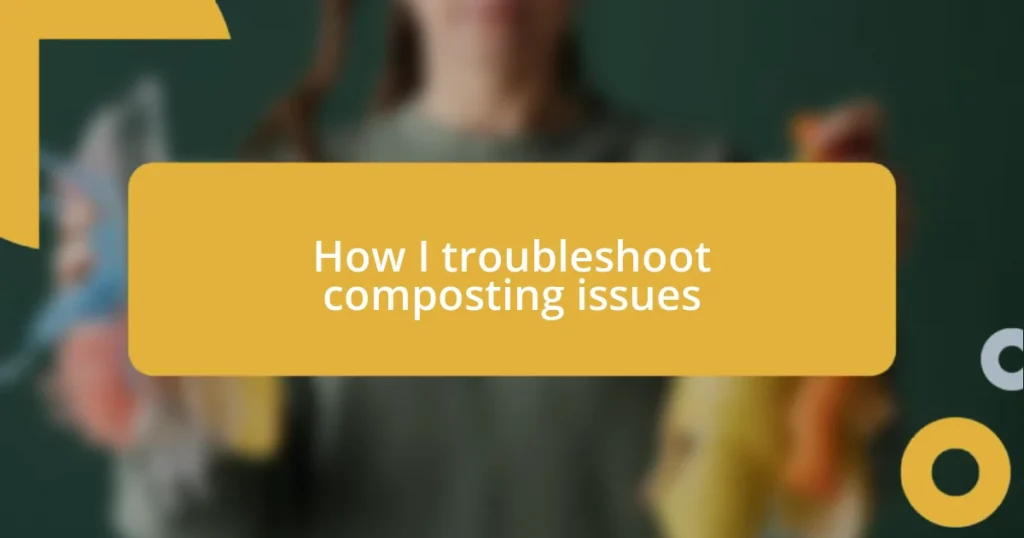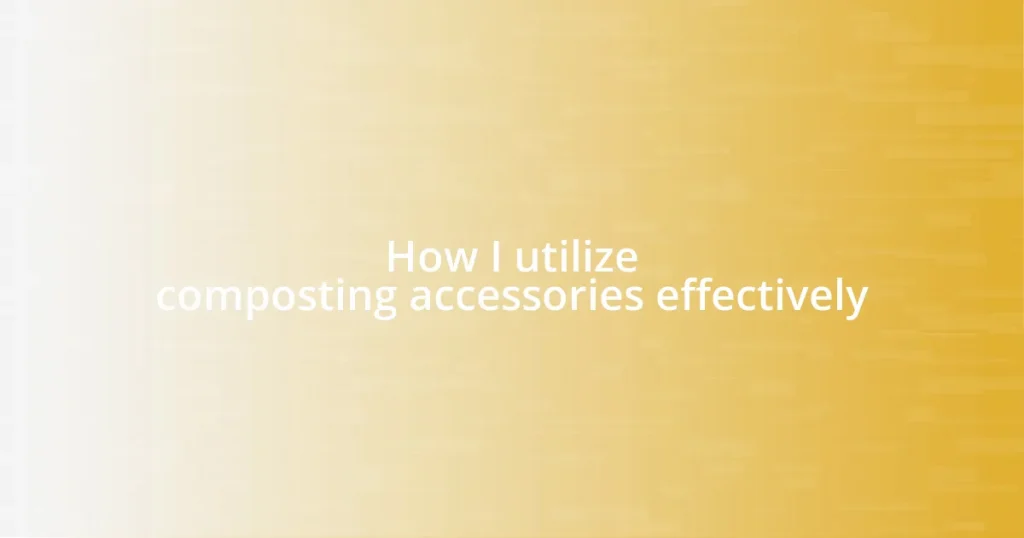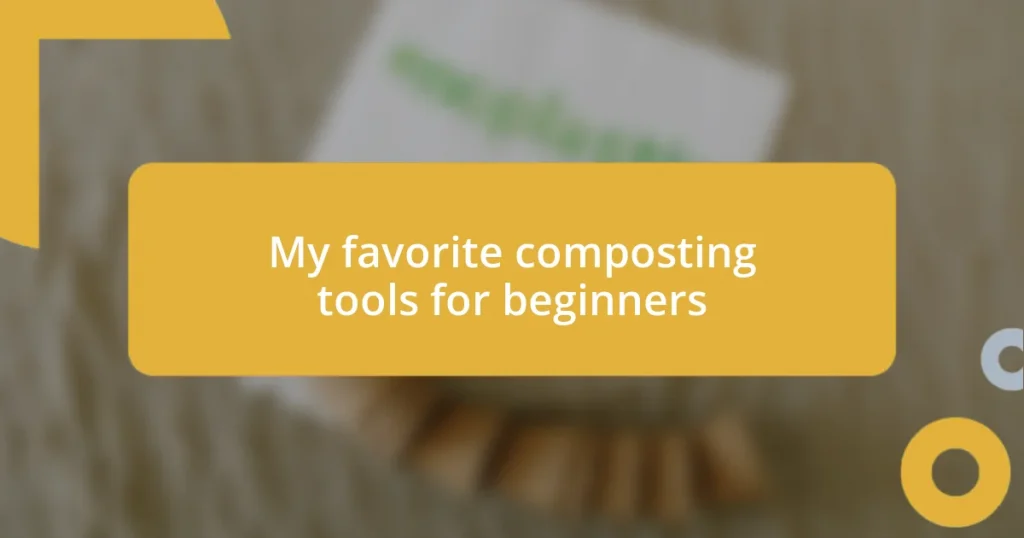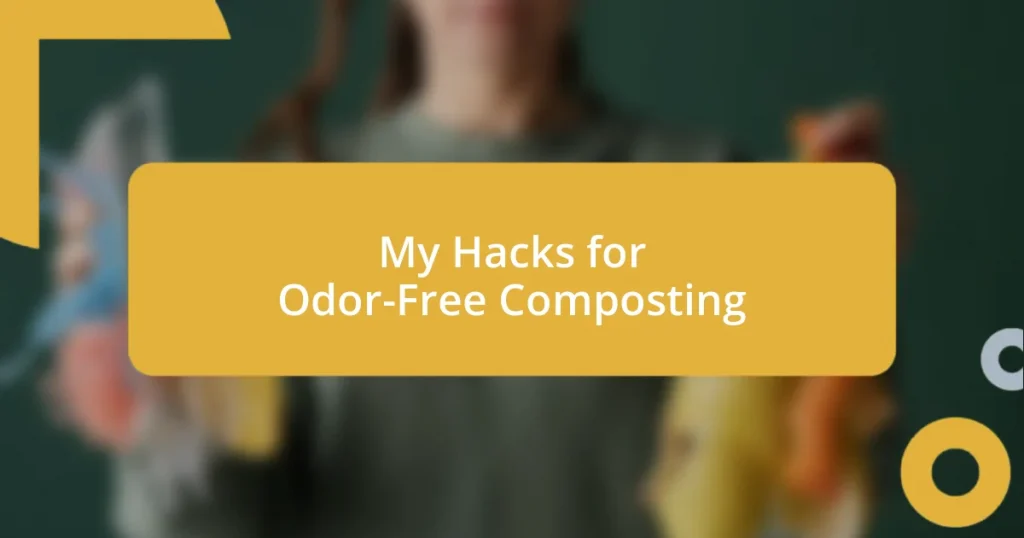Key takeaways:
- Maintaining a balanced mix of green (nitrogen) and brown (carbon) materials is crucial to prevent foul odors and ensure effective decomposition.
- Regularly assessing moisture levels is essential; compost should feel like a wrung-out sponge to promote optimal microbial activity.
- Patience and observation play vital roles in composting; adjustments to the carbon-to-nitrogen ratio and proper aeration can significantly enhance compost quality.

Identifying composting problems
One of the first signs that something isn’t right with your compost is a foul odor. I remember the first time my compost pile smelled like rotten eggs; it was overwhelming! That experience taught me to pay attention to the balance of green and brown materials—too much nitrogen can lead to those unpleasant aromas.
Another indicator of composting issues is the presence of insects or pests. When I noticed fruit flies swarming around my pile, I realized I had been adding too many kitchen scraps without plenty of carbon-rich materials. Have you ever stopped to consider how the composition of your compost affects its residents? That thought can guide you to create a healthier, more balanced environment.
Lastly, if your compost isn’t breaking down and seems to resemble a pile of original materials, it could signal inadequate moisture or aeration. In my early days, I was surprised to find a heap sitting stagnant for weeks. Now, I make it a point to turn my pile regularly and ensure it has the right level of moisture—just enough to feel like a wrung-out sponge. What strategies have you tried to keep your compost thriving?

Common composting issues explained
When I delve into common composting issues, I often find that imbalances are the culprits. One time, I eagerly tossed in my kitchen scraps, only to discover a smelly, slimy mess weeks later. It was a wake-up call, highlighting the importance of maintaining a balanced mix of greens and browns. Too much nitrogen from greens, like grass clippings and fruit peels, can overpower the carbon in browns like dry leaves or shredded paper.
Here are some of the common composting problems you might encounter:
- Foul odors: This indicates too much nitrogen or insufficient aeration.
- Pests and insects: Typically a sign of too many kitchen scraps without enough carbon sources.
- Slow decomposition: Often results from poor moisture or lack of aeration; materials should feel damp but not soggy.
- Uneven texture: Clumps of undecomposed materials can show that the pile needs more turning or mixing of materials.
It’s fascinating how something as simple as the composting balance can lead to a whole range of challenges. I’ve learned to observe and adjust based on what my compost tells me, which has made all the difference in my gardening experience.

Assessing compost moisture levels
Assessing the moisture levels in compost is vital to ensure a successful decomposition process. When I first started composting, I often overlooked moisture management. I vividly recall the moment I discovered my compost pile had turned into a dry, crunchy mess. It was a stark reminder that compost needs to be consistently moist, akin to the feel of a wrung-out sponge. If the materials are too dry, decomposition slows significantly, and we all want to avoid that monotonous wait!
On the flip side, too much moisture can lead to anaerobic conditions, which creates an unsuitable environment for beneficial microbes. I learned this lesson the hard way when my compost became overly soggy, emanating a putrid smell. It felt like stepping into a swamp! I quickly realized that finding that perfect balance requires regular monitoring, using my hands to assess moisture levels. Have you ever wondered how to tell if your compost is just right? Simply grab a handful; if water drips out, it’s too wet, but if it crumbles in your hand, it needs water.
To make it easier to visualize moisture levels, I often use a simple table to compare various moisture conditions in compost:
| Moisture Level | Indicators |
|---|---|
| Too Dry | Crunchy texture, slow decomposition, dust clouds. |
| Just Right | Feels like a wrung-out sponge, decomposing evenly, pleasant earthy smell. |
| Too Wet | Soggy texture, foul odor, slimy appearance. |

Evaluating carbon to nitrogen ratio
Evaluating the carbon to nitrogen ratio is essential for a thriving compost pile. I have learned that this ratio can drastically influence how well the compost breaks down. The ideal mix generally hovers around 30 parts carbon to 1 part nitrogen; however, the real-world application often presents challenges. For instance, if I found myself with overwhelmingly nitrogen-rich green materials, my compost would start to reek instead of developing that delightful earthy aroma we gardeners crave.
In my early composting days, I once got carried away with the excitement of adding kitchen scraps, thinking they would create the perfect blend. What I didn’t realize was that my carbon sources were lacking, leading to a smelly disaster. I remember the feeling of hopelessness as I tilted my head toward the pile, waves of putrid odor hitting me like a brick. Since then, I’ve made it a point to strike a balance, adding shredded cardboard or leaves to counteract the green waste.
Paying attention to this ratio not only enhances decomposition but it has also transformed my outlook on composting. Are you often weighing the benefits of adding more greens versus browns? I’ve learned to keep a mental note of each ingredient’s contribution. It’s fascinating how a simple measurement can unlock the potential of my compost, transforming it from a chaotic heap into a nutrient-rich treasure.

Managing temperature and aeration
Managing the temperature and aeration of my compost pile has become a crucial part of my composting routine. I’ve discovered that a well-balanced temperature, ideally between 130°F and 160°F (54°C to 71°C), accelerates the decomposition process. I remember the excitement I felt seeing my pile reach that sweet spot after several days of care; it’s like watching a pot boil – you don’t want to let it sit too cool or too hot. To check the temperature, I use a simple compost thermometer which has quickly become my best friend in the garden.
Aeration is equally important, and my journey taught me that stirring the pile frequently can make a significant difference. Not long ago, I neglected this step and encountered a stagnant layer of compost that reeked of decay. That scent overwhelmed me, and it hit me hard – it was clear my beloved microbes needed oxygen to thrive. I’ve made it a habit to turn my pile every few weeks, and now I feel a sense of accomplishment when I see the rich, fragrant compost developing. Have you felt the satisfaction of turning over a compost pile and catching a whiff of that earthy aroma? It’s one of gardening’s hidden joys!
I’ve also learned that ensuring proper aeration facilitates the composting process. When I first dove into composting, I initially stuffed my pile too densely. This made it challenging for air to circulate, resulting in uneven breakdown. It was a bit disheartening, experiencing that slow decomposition. Now, I focus on layering materials and mixing them well, which creates pockets of air that help the microorganisms do their job efficiently. Have you ever tried mixing in wood chips or straw for better aeration? Those little tricks have made a world of difference in my composting success!

Recognizing pest and odor issues
Recognizing pest and odor issues in my compost pile has been a real eye-opener. I’ll never forget the first time I spotted fruit flies buzzing around my bin. It was like an unwelcome party I never invited! That’s when I realized adding too many soft fruits without balancing the browns could draw in pests. I learned that a vigilant eye can save us from an infestation that disrupts the entire composting process.
Then there’s the smell—oh, the smell! I remember the sinking feeling in my stomach when my compost began to emit a foul odor that wafted into my kitchen. It was alarming! It turned out my mixture was too heavy on nitrogen, creating an anaerobic environment that produced those unpleasant scents. Since that experience, I’ve made it a habit to check for a balanced smell; it should be earthy and sweet. Learning to associate odors with different composting issues was a game changer for me.
Now, let’s talk about small critters. I’ve had my fair share of unwelcome guests: slugs. Last spring, I found them nesting happily among my compost. It hit me that I was probably adding too many damp materials without enough structure. Now, I add layers of dry leaves or straw to minimize moisture and keep those pests at bay. Do you ever feel that rush of relief when you spot a well-balanced, thriving compost pile? I find it incredibly rewarding to keep both pests and odors under control with a little mindfulness and effort!

Solutions for troubleshooting compost
When I face issues with my compost, I’ve learned to troubleshoot by observing the material closely. One time, I found my compost pile was dry and crumbly, which led me to realize that my moisture levels were off-balance. I began to introduce water by adding in layers of damp kitchen scraps, and just like that, the life returned to my pile. Have you ever noticed that a little moisture can breathe new life into a seemingly lifeless compost?
One of my most effective solutions has been experimenting with the carbon-to-nitrogen ratio. I remember the relief I felt when I adjusted my mix to create that perfect balance—typically around 30 parts carbon to 1 part nitrogen. My composting journey took a turn for the better once I recognized the importance of measuring. Now, I keep a chart handy so I can visualize what to add if things feel off. How do you maintain your ratios? It’s a bit like cooking; once you find the right recipe, everything comes together beautifully.
Lastly, I can’t stress enough the importance of patience and observation. I recall a time when I tried to rush the process, checking on my compost too frequently and doubting its progress. That’s when I really learned that composting is a waiting game—allowing nature to work its magic. I now schedule monthly checks and learn to appreciate the little changes. Do you find joy in watching the transformation over time? It’s fascinating to see how a pile of scraps can evolve into black gold with just a bit of attention and care!















